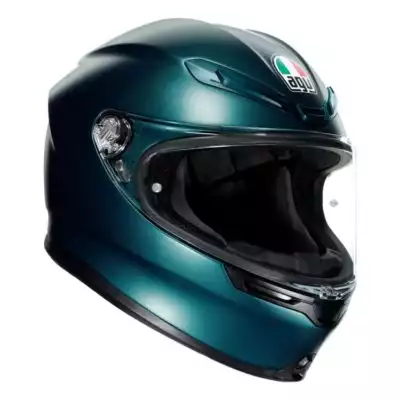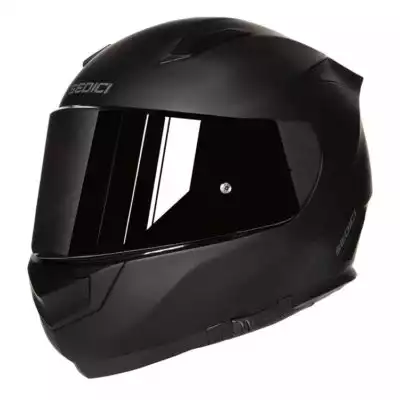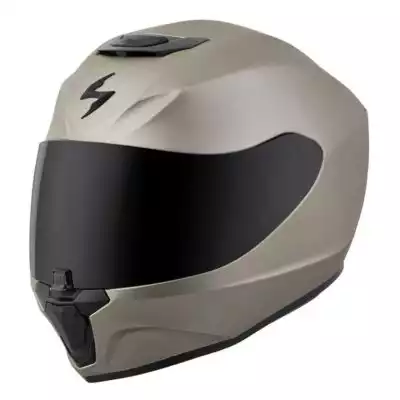Full-face helmets are my go-to. I like the safety they provide in addition to the reduced noise and wind.
Since I’m always scouring the market for the newest and most effective models, I decided to make a list of the top five best full-face motorcycle helmets I’ve found and just what it is about them that I like so much.
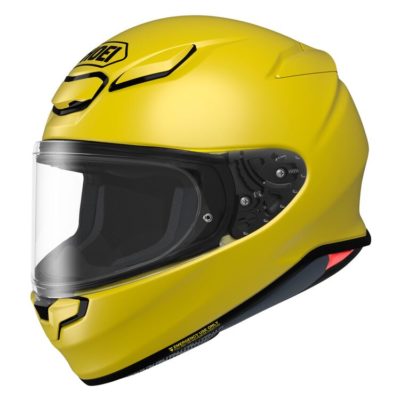 Shoei RF-1400 Helmet
Shoei RF-1400 Helmet
The Shoei provides safety and comfort in a stylish package. Meeting SNELL M2020 safety standards, the RF-1400 offers you quality protection along with advanced ventilation and four shell sizes for the right fit.
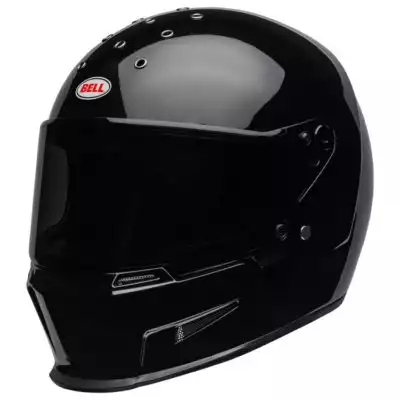 Bell Eliminator Helmet
Bell Eliminator Helmet
If you're on a budget but still want top-shelf features, the Eliminator is for you. It’s a super lightweight but safe helmet that's easy on your wallet.
Reviews of the Best Full-Face Motorcycle Helmets
Shoei RF-1400
Shoei is pretty much top of the line when it comes to helmets, so it’s no surprise that its flagship full-face model topped my list of favorites.
For one thing, it’s super safe, made of EPS foam that absorbs and dissipates the force of an impact without being too heavy. As a result, it doesn’t just meet DOT requirements but SNELL M2020 as well.
One unique safety feature I really like is the emergency quick-release system. This lets paramedics take off the helmet without moving your neck, which could cause permanent damage after an accident.
Of course, to get the top spot, the RF-1400 also had to be comfortable. What I like best is that it has four different shell sizes that make it a lot easier to get a precise fit based on your head size, which Shoei offers up to 3XL.
The temperature regulation is also top notch on this model. This is mainly due to the extensive but still quiet ventilation that includes six different intake vents and four exhaust vents. I also like the second-generation Max-Dry liner, too, since it wicks away sweat to keep the inside of the helmet less stuffy and more comfortable.
Add all this to multiple color options to match your style and a wide field of vision that’s both safe and inconvenient, the RF-1400 was an easy choice for the best full-face helmet overall. You just have to be willing to pay the top-shelf price.
Pros:
- Lightweight but safe EPS liner that meets SNELL M2020 standards
- Emergency quick-release system
- Four shell sizes
- Extensive ventilation
- 3D Max-Dry sweat-wicking liner
- Six color options
- Wide field of vision
Cons:
- Top-shelf price
Bell Eliminator
I love Bell. It makes affordable products that are often as good as, if not better than, the equivalent name-brand model. That’s certainly the case with the Eliminator, my budget recommendation for a full-face helmet.
In full disclosure, downsides first. The main thing that fits the “get what you pay for” saying is the noise level. The ventilation isn’t very advanced and can really make it loud inside the helmet at high speeds. Additionally, you only have three color options: black, gray, and white.
Otherwise, though, the Eliminator rivals top-shelf helmets. Where it really stands out is its lightweight fiberglass design that’s safe but easy on your neck and shoulder muscles when riding for long periods of time.
I also like the contoured cheek pads. They break in easily and should fit most head shapes well, especially thanks to the three different shell sizes combined with five EPS sizes.
Pros:
- Budget price
- Extremely lightweight
- Fiberglass shell meets DOT standards
- Contoured cheek pads
- Good sizing
Cons:
- Limited color options
- Loud
AGV K6
AGV is another name brand, and the K6 is my favorite of its full-face helmets. I like that it has a lot of top-shelf features but has a more mid-range price than some other name-brand models.
In particular, the K6 is super lightweight due to the tough carbon-aramid shell. In fact, it comes in at under three pounds, something you almost never see. That makes it ideal for touring or cruising.
Plus, it’s easier to get a good fit because there are four shell sizes. Altogether, it’s one of the most comfortable helmets I’ve found.
I was surprised that the ventilation only consisted of one exhaust vent since it has five intake vents. However, the ventilation is still good, if not the best on the market.
All that said, my absolute favorite thing about this helmet is the style. It looks great, especially in the unique Matte Petrolio color option.
Pros:
- Good value
- Extremely lightweight, under 3 lbs
- Carbon-aramid shell
- Four shell sizes
- Stylish color options
Cons:
- Only one exhaust vent
Sedici Strada II
The main draw of the Strada is its quiet design. I even put it on my list of the quietest motorcycle helmets. Thanks to a seamless face shield gasket that prevents wind from entering through the front in addition to a removable wind skirt, it’s a good helmet for any rider who spends a lot of time on the highway.
Another unique thing about this helmet is the Kevlar shell. Considering this is the same material used in bullet-proof vests, you can bet it’s safe, and the Strada does indeed meet DOT standards.
However, Kevlar also means it’s lightweight, just 3.3 pounds. Again, good for highway riding.
Finally, I like how adjustable the ventilation is on this helmet. There are four intake vents altogether, and they each have three settings. This helps cut down on noise and keeps you cool in hot weather.
Pros:
- Quiet design
- Lightweight but protective Kevlar shell
- Adjustable ventilation
- Aerodynamic shape
Cons:
- Prominent face-shield switch can get in the way
Scorpion EXO-R420
I consider the EXO-R420 to be one of the best helmets for big heads. This is mainly because it has sizes up to 4XL, fitting head circumferences up to 27 inches.
It’s all around comfortable, as well, with a KwikWick interior that breaks in quickly and conforms to the shape of your face in addition to wicking away sweat for better temperature control.
The first thing you’ll notice about the EXO-R420 is probably the design, though. It’s pretty unique, and while it probably doesn’t fit all tastes, I really like the sleek, aerodynamic look. One benefit of the streamlined design is the wider field of vision, with the face shield extending back towards the ears.
Pros:
- Sizing up to 4XL or 27 inches
- Great value
- Antibacterial, washable, moisture-wicking interior
- Breaks in easily
- Stylish look
Cons:
- Tinted face shield not included
- Only two shell sizes
Buyer’s Guide
Considerations, Care and Costs
Safety and Protection
The first thing you should check when considering a full-face helmet is, of course, the safety. That’s a helmet’s main purpose and probably the reason you’ve opted for the full-face design.
The main safety factor is simply the ability of the shell and inner lining to absorb the force of an impact so that your head doesn’t. While any helmet manufacturer will go into detail about the efficacy of their specific material, be it carbon, Kevlar, fiberglass, etc., the easiest way to judge a helmet’s safety is by its safety rating.
A helmet should at least meet the standards set by the Department of Transportation, which you’ll see listed as DOT. However, really safe helmets can get a more rigorous rating from the Snell foundation. Motorcycle helmets meeting the most recent requirements receive the certification SNELL M2020.
Further reading: In-depth guide to helmet safety standards
Other safety features include things like the chin strap and the field of vision, which you want to be wide enough to see vehicles around you. One feature I particularly like to look for on full-face helmets is an emergency quick-release system, which allows paramedics to remove the helmet without moving your neck after an accident.
Sizing and Fit
Getting an appropriately fitting helmet is important, not just for comfort but for safety as well. As a brief summary, a helmet should be snug enough that it doesn’t slide around when you move your head but not so tight that it begins to hurt.
The easiest way to get a properly sized helmet is to measure your own head circumference and then consult the manufacturer’s sizing guide as there’s no exact standard in the industry. You may be a medium in one brand and a large in another.
Also, pay attention to head shape. Helmets are rated for three head shapes: round oval, intermediate oval, and long oval. Most people have intermediate oval heads, so most helmets are designed for this head shape. Be extra careful if you have one of the other two since you may need to search a little harder for a helmet that fits you.
Interior Lining and Comfort
The interior lining and the cheek pads of your helmet play a big role in how comfortable it is.
First and foremost, you want one with soft, spongey cheek pads that will provide cushioning while still adapting to the shape of your face. The best way to get this is with washable cheek pads. By washing them, you can fluff them back up so they remain soft.
The interior lining is also important for temperature regulation and your comfort during hotter weather. Ideally, you want it to be made of a moisture-wicking fabric that pulls sweat off your skin and humidity out of the air. This helps you cool down.
Ventilation
Without ventilation, summer can be unbearable inside a full-face helmet. It can also cause the helmet face shield to fog up from your breath.
Make sure the full-face helmet you get has a good system of ventilation that includes multiple intake vents in different places to promote airflow. An especially good feature is the ability to adjust the vents for maximum comfort.
Read about the top ventilated helmets.
Noise
When you get up above 55 mph, there’s a lot of wind hitting you. Without the proper precautions, this can result in a lot of noise.
Helmets can cut down on this noise with well-designed ventilation and interior linings as well as minimal seams in the helmet’s shell. If you ride on the highway frequently or for long periods of time, you definitely want to find a quiet helmet.
Vision and Face Shields
One of the downsides of full-face helmets is that they crowd your vision. To help with this, look for a helmet that has a wide face shield that extends around the sides to give you some peripheral vision. This helps you see other vehicles and keep track of your surroundings.
I also recommend choosing a helmet that can receive a Pinlock insert if one isn’t already included. Pinlock inserts help prevent fogging that could impair your vision and increase your chances of an accident.
Final Thoughts
A full-face helmet is the best way to protect your head while enjoying your motorcycle. In my opinion, the best full-face helmet is the Shoei RF-1400. If you’re on a tight budget, also check out the Bell Eliminator.
